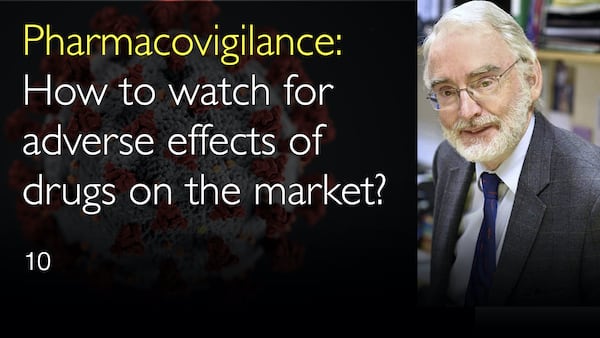Leading expert in pharmacovigilance, Dr. Stephen Evans, MD, explains how to detect adverse drug reactions after medications reach the market. He emphasizes the importance of large electronic health record database surveillance. Dr. Evans advocates for simplified physician reporting systems to capture suspected adverse effects. He discusses the challenges of false positives and false negatives in adverse event detection. Continuous monitoring of new and existing drugs is essential for patient safety.
Effective Pharmacovigilance Strategies for Monitoring Drug Safety Post-Approval
Jump To Section
- Electronic Health Record Surveillance
- Physician Adverse Event Reporting
- Patient Reporting Systems
- Big Data Analytics in Pharmacovigilance
- Challenges in Adverse Effect Detection
- Improving Drug Safety Monitoring
- Full Transcript
Electronic Health Record Surveillance
Dr. Stephen Evans, MD, emphasizes the critical role of electronic health record databases in pharmacovigilance. He explains that continuous monitoring of large healthcare databases is essential for detecting adverse drug reactions. This approach allows researchers to identify potential medication safety issues that may not have been apparent during clinical trials.
Dr. Evans specifically highlights the importance of monitoring new drugs through electronic health records. He notes that comprehensive surveillance should include both newly approved medications and existing pharmaceutical products. This systematic approach enables earlier detection of rare or long-term adverse effects that might otherwise go unnoticed.
Physician Adverse Event Reporting
Dr. Stephen Evans, MD, discusses the vital importance of physician reporting in pharmacovigilance systems. He states that healthcare professionals are particularly skilled at identifying potential medication-related adverse effects. Their clinical experience allows them to recognize patterns that might indicate drug safety concerns.
Dr. Evans advocates for making adverse event reporting as simple as possible for physicians. He emphasizes that reducing the administrative burden on healthcare providers encourages more comprehensive reporting. Regulatory authorities worldwide, including the FDA in the United States, benefit from this streamlined reporting process.
Patient Reporting Systems
Dr. Stephen Evans, MD, addresses the role of patient-reported adverse events in pharmacovigilance. He notes that in the UK and Europe, patients can directly report suspected medication side effects to regulatory authorities. This patient-centered approach provides additional data points for drug safety monitoring.
However, Dr. Evans observes that patients often report minor side effects that may be personally significant but less clinically urgent. While these reports contribute to overall medication safety profiles, he emphasizes that physician reports remain crucial for identifying serious adverse drug reactions that require immediate regulatory attention.
Big Data Analytics in Pharmacovigilance
Dr. Stephen Evans, MD, explores the application of big data approaches to pharmacovigilance. He describes how advanced computing methods can analyze massive electronic health record datasets to detect potential adverse effects. These analytical techniques can identify patterns that might escape traditional surveillance methods.
Dr. Stephen Evans, MD, explains that specialized analysts work with incoming safety data to identify concerning trends. Dr. Evans mentions that these big data approaches represent the cutting edge of medication safety monitoring. They enable researchers to process vast amounts of information more efficiently than manual review methods.
Challenges in Adverse Effect Detection
Dr. Stephen Evans, MD, acknowledges the significant challenges in accurate adverse effect detection. He compares the process to diagnostic testing, noting that both false positives and false negatives occur in pharmacovigilance. False positives identify non-existent harms, while false negatives miss actual medication risks.
Dr. Stephen Evans, MD, explains that these detection challenges are inherent to medication safety monitoring. Despite advanced surveillance systems, some adverse effects may remain undetected initially. He emphasizes that continuous improvement in monitoring techniques helps minimize both types of detection errors over time.
Improving Drug Safety Monitoring
Dr. Stephen Evans, MD, outlines strategies for enhancing pharmacovigilance systems worldwide. He stresses that better surveillance in electronic health record databases represents a primary improvement opportunity. Comprehensive data collection and analysis enable more effective detection of medication-related harms.
Dr. Evans concludes that optimizing both electronic surveillance and physician reporting systems is achievable. He believes that implementing these improvements will significantly enhance medication safety for patients. During his discussion with Dr. Anton Titov, MD, Dr. Stephen Evans, MD, emphasizes that ongoing refinement of pharmacovigilance methods remains essential for public health protection.
Full Transcript
Dr. Anton Titov, MD: Professor Evans, you're an expert in pharmacovigilance—continuous surveillance of adverse drug effects after the medication is approved, when doctors start prescribing it to patients. What are the best practices to detect adverse drug reactions to medicines that are already on the market? And what are the common problems today with adverse drug effects surveillance?
Dr. Stephen Evans, MD: To me, there are two things that we can do in large measure. The first is that, assuming that all the trials that can be funded have been carried out, we need to do better surveillance in large electronic health record databases. We need to make sure that the data in those are able to be used for research and is having continuous monitoring.
Particularly of new drugs, but also of all drugs, so that where harms are occurring, we can detect them. In some areas, we do not do that very well based on records.
The second thing that we can do is make it easier for physicians to report suspected adverse reactions. Human beings, whether patients or health professionals, are very good at being suspicious that medicine has caused an adverse effect. Sometimes, indeed a lot of the time, that suspicion is incorrect.
Nevertheless, having that suspicion is worthwhile. Making the process of reporting that to the FDA in the US, or regulatory authorities around the world, ought to be a minimal effort for the physician or health professional who sees that particular effect.
In the UK, and indeed in Europe, we have been allowing patients to report such things themselves. But they often report the trivial ones, which can be important to them and may be important for regulators to know. We really need very good reporting from physicians.
Making that process as simple as possible is, I think, the thing we can do best. I have done both of those things. We have analysts who are able to analyze the data that comes in, and we can use perhaps very big data—to use the buzzword—in the era of computing big data approaches to electronic health records to be able to detect potential adverse effects.
The problem is, of course, that a bit like diagnostic testing, you will have false positives and false negatives. You will find harms where there isn't really any, and you will fail to find harms where there are some. But doing all of this better is possible.







